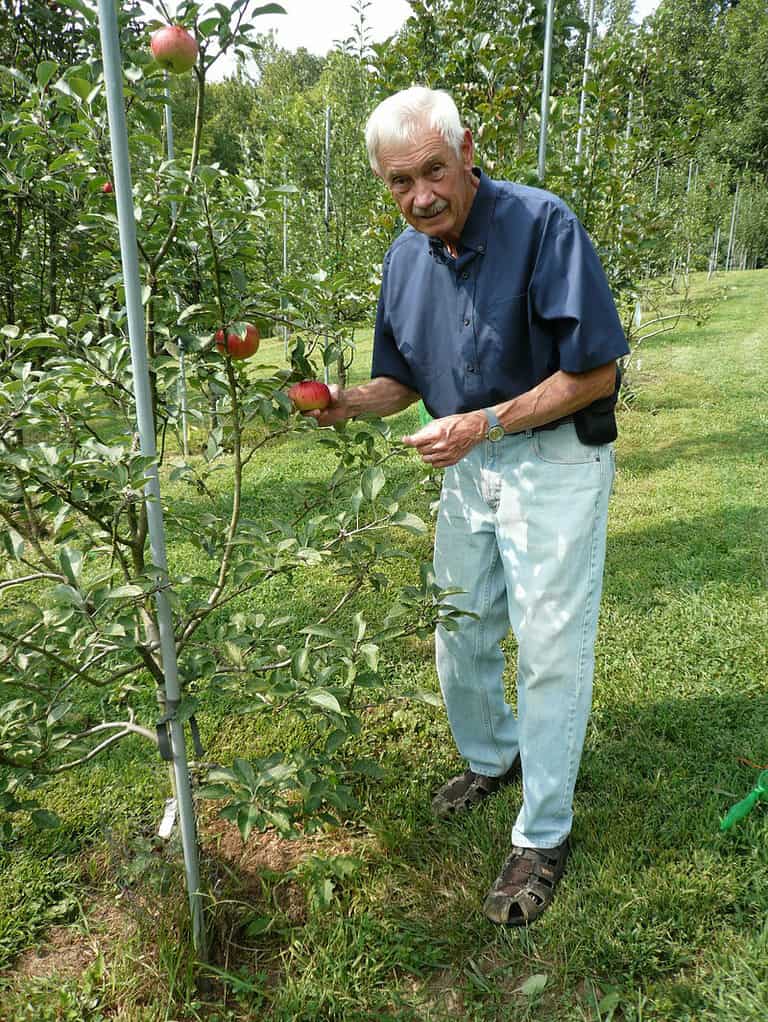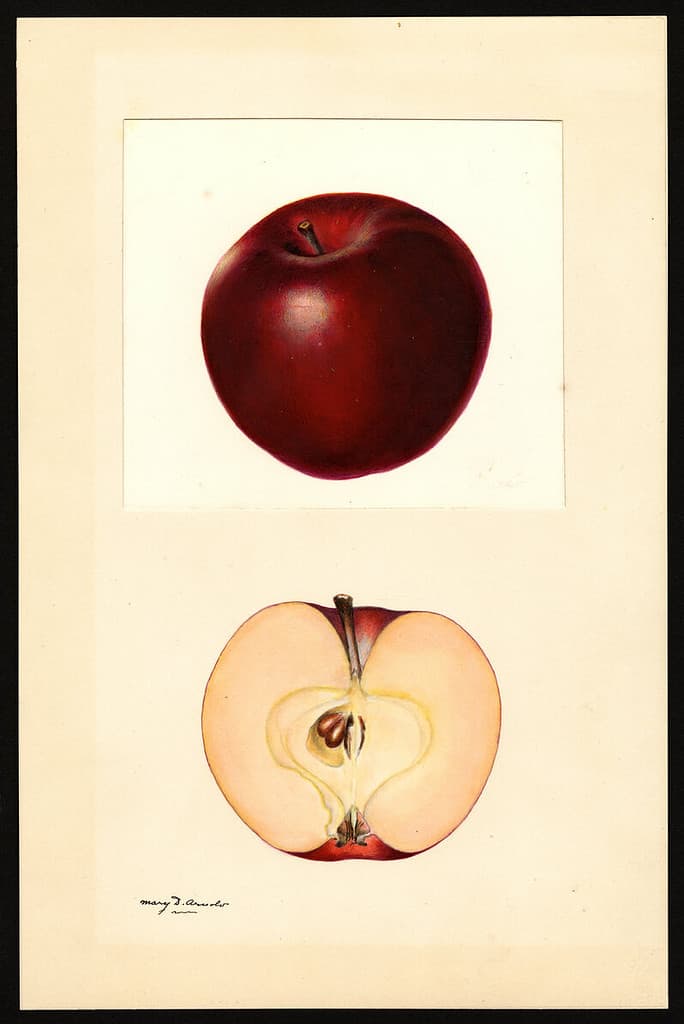
Or how one person looking for a retirement hobby can make a difference.
Tom Brown proudly guides a pair of young, aspiring homesteaders through his own apple orchard in Clemmons, North Carolina. This 79-year-old retired chemical engineer single-handedly managed to save more than 1,000 varieties of apples in danger of extinction from certain death.
The varieties have roaring names and every now and then he pauses during his story. All unknown names such as Black Winesap, Candy Stripe, Royal Lemon, Rabun Bald, Yellow Bellflower and Night Dropper.
Take the Junaluska apple. Legend has it that the variety was standardized more than two centuries ago by Cherokee Indians in the Smoky Mountains and named after its greatest patron, an early 19th-century chieftain. Legend has it that the apple was once a Southern favorite, but disappeared around 1900. Brown began hunting for it in 2001 after discovering references in an Antebellum-era orchard catalog from Franklin, North Carolina. Like a true detective, he set out to locate the orchard, which closed in 1859. He then engaged a local hobby orchard and postman as researchers. The two spent days asking door-to-door questions about old apple trees. Finally, an elderly woman led them to the remains of a mountain orchard that had long been engulfed by forest.
Brown returned during the fruiting season and used historical records to identify a single, gnarled Junaluska tree. He grafted scionwood for his new conservation orchard and began to reintroduce the apple to the world.
But these are just some of his stories. His quest for the heirloom apples of Appalachia lasted more than 25 years. Or this Arkansas ‘black apple’ that is at its best after months of maturing.

His collection now includes about 1,200 varieties that have been given a new lease of life on his two-hectare orchard.
The ‘Heritage Apple’
His Heritage Apple collection alone contains 700 of the rarest varieties. Most have not been sold commercially for a century or more; some were cloned from the last known trees of their kind.
He had no idea what a ‘Heritage’ apple was at first until he came across them at a historic farmers’ market in 1998. “There was a booth with a bunch of strange looking apples in baskets,” Brown says.
The colors ranged from bright green to streaked yellow, sunset pink, and purplish black. Some were the size of a plum, others the size of softballs. They had names like Bitter Buckingham, White Winter Jon, Arkansas Black and Billy Sparks Sweetening. When he started tasting, he discovered a completely new palette of flavors and textures.
Brown tasted Jonathans with rosé wine-colored flesh. Rusty Coats were soft as pears and sweet as honey. The Mammoth Twenty Ounce was crunchy with a tart, peachy finish. Semi-firm Etter’s Gold brought peonies and grape aromas. Grimes Golden was sweet with a hint of nutmeg and white pepper.
His enthusiasm led to a conversation with the seller, the late orchardist Maurice Marshall. The apple varieties he sold were standardized in the 18th and 19th centuries and had disappeared from commercial circulation by 1950. Marshall had obtained most of the scionwood for them from older mountain farmers. But two or three varieties came from clippings taken during apple-hunting expeditions in the ruins of old orchards. In addition, hundreds of lost apples can likely be recovered from similar locations in the Appalachian Mountains.
“That part stuck with me,” Brown says. “I kept thinking, ‘How nice would it be to find an apple that no one has tasted in 50 or 100 years?'”
Then it dawned on him: had so many interesting, great-tasting fruits really gone missing? It seemed impossible. Brown threw himself into researching the history of Appalachia’s heritage apples. What he discovered was quite shocking.

Commercial orchards in the U.S. grew about 14,000 unique varieties of apple in 1905, and most of them were found in Appalachia, says William Kerrigan, author of Johnny Appleseed and the American Orchard and a professor of American history at Muskingum University.
The diversity was rooted in early colonial precautions.
Cider the settlers’ favorite drink
“Water wasn’t always safe to drink, and episodes of illness from contaminated water gave that substance a dubious reputation,” Kerrigan says. Fermented drinks were the alternative. Importing wine was expensive and native pests killed Old World grapes. Apple orchards were easier to maintain and more useful than growing barley fields for beer, so cider became the settlers’ favorite drink. By the mid-18th century, virtually every ranch and ranch on the East Coast had an apple orchard.
The establishment of the Blue Ridge Mountain region in Virginia provided an innovation boost.
High but not too high elevations, hot, humid summers and rich, deep soil fed by consistently rainy winters made for ideal growing conditions, writes Kerrigan in Johnny Appleseed and the American Orchard.
By the early 1800s, the Shenandoah Valley had become the primary growth region of the US. Commercial orchards spread in the eastern Appalachians. Experimentation was relentless.
Growers were doing things like crossing tannin-rich native crabapples with Old World cider staples, Kerrigan writes. The efforts spawned new varieties, such as the Taliaferro, which Thomas Jefferson championed as the world’s largest cider apple.
But apple varieties were grown for more than just cider.
Variation on the menu
For Appalachian ranchers and ranchers, “a diverse orchard was fundamental to survival and nutrition,” Brown says. Residents were expert gardeners and developed varieties that matured at different intervals, tasted unique and suited specific culinary functions.
“The goal was to be able to pick fresh apples from June to November and have a diverse range of fruit year-round,” says Brown. Late-ripening varieties with thick skins made for delicious winter treats. Others were adapted for applications such as deep-frying, baking, dehydrating, making vinegar, and slaughtering livestock.
Apples were the crown jewels of the garden, says Travis Milton, co-founder and renowned chef of Appalachian Food Summit. People took pride in having something unique to brag about to their neighbors.
But the Appalachian traditions surrounding heirloom apples were eroded and eventually destroyed by urban migration, factory farming and corporate food systems. Conglomerates negotiated national contracts and switched to apples that ripen quickly and were suitable for long-haul transportation. By 1950, most of the smaller orchards had gone out of business—Milton’s grandfather, for example, sold the Wise County, Virginia, orchard to a coal company to save his cattle ranch. Gardens began to disappear.
From 11,000 Heritage varieties to 11
By the late 1990s, U.S. commercial orchards were growing fewer than 100 varieties of apples—and only 11 of them accounted for 90 percent of grocery store sales. Experts estimate that 11,000 Heritage varieties were extinct.
“It upset me to learn that,” Brown says. Two hundred and fifty years of culinary culture had been wasted. “These were foods that people once cared about, that were central to their lives. It felt wrong to just let them die.” “But if Marshall was right, some of Appalachia’s heritage apples could still be recovered. And Brown was looking for a retirement hobby. His experience as a scientist would bring a calculated organization to searches. The project would allow him to trace the history of explore and learn more about rural Appalachian communities.
Found his calling
Brown realized he had stumbled upon “what can only be described as a ‘calling’.” His pursuit of the Heritage apple became his calling. In the meantime, he can rightly call himself an expert.

Marshall introduced Brown to a network of aging, small-scale heritage orchards (none of them kept more than 20 varieties) who taught him the basics of identifying, cloning, grafting, and maintaining trees. He discussed lost apple varieties and made lists of names, including characteristics, former growing sites and rumors of where trees still existed.
Connections to regional historical societies yielded old orchard maps, fruit grower association newsletters, and names of former owners and workers. Pomology historians helped Brown locate vintage orchard catalogs with drawings and descriptions for thousands of lost varieties.
His early search and rescue efforts centered around former production breeding grounds, such as the Brushy Mountains in North Carolina. The two-county region was home to more than 100 commercial orchards in 1900. Brown advertised in regional newspapers looking for information about old apple trees.
“The response was exciting, but also kind of [een reality-check]said Brown. He answered dozens of phone calls, but few offered concrete information. Most of the callers were in their 80s and 90s, Brown says, telling stories from their childhood where “an old man so-and-so had a tree with 20 different kinds of apples grafted on it.”
Until then I hadn’t understood how much detective work this would require
Tom Brown
Years of ad hoc efforts helped him develop central strategies for hunting. First, he collects clues about the possible whereabouts of trees. For example, if you discover the address of someone’s great-grandparents who once owned a large orchard, you can locate a rural community where special trees may still exist. Brown then draws a beam around the property and scans nearby houses. He stops by local businesses to inquire.
“When I explain what I’m doing, most people are really helpful,” Brown says.
For example, a conversation with an 80-year-old at a rural store in northeast Georgia led Brown to amateur orchardist Johnny Crawford. Crawford introduced Brown to elders in the Speed family, who eventually helped him find a treasure trove of rural area heirlooms, including the Royal Lemon, Neverfail, Candy Stripe, and Black Winesap.
When Brown finds a tree, he takes cuttings with him and returns during the fruiting season to identify them. He compares leaves and apples to catalog items and uses photos to correspond with experts for further verification.
He drives about 30,000 miles a year and spends about three days a week apple hunting. Its partnerships with municipalities and non-profit organizations, such as the Southern Foodways Alliance, help establish reclaimed varieties in additional orchards and ensure their survival.
Brown has rescued many varieties of the once-popular apple juice, including the red wine juice.
Saving an apple from the brink of extinction is a wonderful feeling.
Tom Brown
It’s incredibly rewarding – and incredibly addictive!
His orchard is full of clones of trees recovered from Georgia, South Carolina, North Carolina, Kentucky, Tennessee, Virginia, West Virginia, Maryland, and Pennsylvania. He splits his time between hunting apples, tending trees, donating scionwood to nonprofit heritage orchards and selling about 1,000 saplings a year.

Brown’s work has been praised by conservationists and culinary professionals. Chefs like Travis Milton are eager to have hundreds of new flavors to experiment with. Artisan cider makers say reintroduced heirlooms are inspiring a cider renaissance.
“Tom helped redefine what is possible,” said Diane Flynt, owner of Foggy Ridge Cider, which won a 2018 James Beard Foundation award. She says heirlooms like Hewes Virginia Crab and Arkansas Black are to Appalachia what noble grape varieties like Merlot or Cabernet Sauvignon are to Bordeaux.
Brown is pleased that the apples are being put to good use. But he is quick to note that many have yet to be rescued. And they are getting harder and harder to find. “It probably takes me 20-30 times more work and a lot more driving to find a new tree,” Brown says. But that doesn’t stop him. Meanwhile, he’s thinking not of quitting, but of restoring the Heritage apples of Appalachia as his “true life’s work.” While he hopes to find 100 varieties or more in his lifetime, just seeing one more find would be enough.